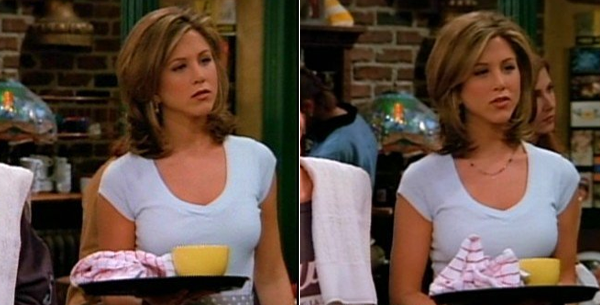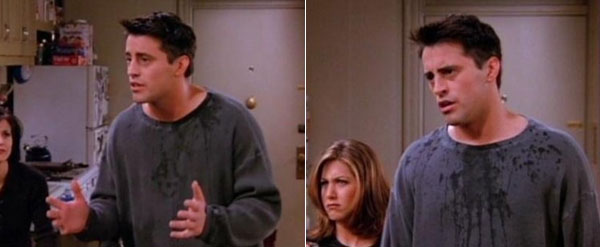Random
Mistakes Friends Made

In the second season of Friends, Rachel—in what could be construed by the spiritual as divine intervention—is seen, between takes, suddenly wearing a necklace. The famous episode concerns Ross, whose budding relationship with another woman (they recently acquired a cat) summons dormant feelings in the waitress, whose real life actress, Jennifer Aniston, is to go on—through divorce and a kind of, in my mind, nobly unmarketed depression—to embody the developing cougar. They kiss for the first time in this episode, the laugh track giggles supplemented by oohs and awws. In this modern Romeo & Juliet, a “conceited tragedie” according to the 1597 first edition title page, the two rivaling families are replaced by the likewise quarrelsome rent vs. romance. Rachel’s spontaneous, perhaps wishful, necklace is captured by Movie Mistakes, a website featuring stills of logical inconsistencies in popular television and film. While these may all be simply attributed to overworked P.A.s occasionally letting logic slip by, each incident has spiritual gist, if by “spiritual” we mean the irrational answer to irrational quandaries: the sudden appearance of an object, or feeling.
Of green-motif and idle patronage, Central Perk is a subliminal Starbucks, though one may wonder why these recent college graduates are not—if art presumes to hold a cracked unlucky mirror to life—drinking away their day’s earning at a bar. May we look for ourselves in the surface of a cocktail, Bacchus meets Narcissus in the grand delusion that tomorrow is different. Friends can be remembered as a fountain of youth eventually dried—the actors, aged in real time, chronically slipping into their timeless costumes of stunted relationships and careers, as if time sympathetically only existed 30 minutes at a time, forever embalmed under cellophane in a new DVD, the discount sticker fading under the incandescent Target lights.

When lamenting gentrification, the greatest commodity is time, as one “consumes” the chronological lineage of how long they’ve resided in the gentrified city, defining the problem loosely as “those who’ve moved here after me,” an arbitrary line drawn in the sand by a most imperialist of middle-fingers. The beauty of gentrification is that the artisan cheese slowly crawls towards me. The vocations of our friends—waitress, aspiring actor, unsigned musician, home caterer, adjunct lecturer (besides Chandler, whose early corporate fate and spiritual resignation made him the most husband/mortgage material)—would have socioeconomically put them in New Jersey or the Bronx, not Manhattan, in a bohemian penthouse in a “lively” part of town. The dream-feel of the show is Disney’s version of being lost, the women as Sleeping Beauty waiting for their awakening, a chivalrous Tom Selleck waiting off screen.
I think about the P.A. whose job it was to pour water on Joey for reasons this contributor researched by could not find. The best explanation of entropy is a bowl of salt and pepper bisected neatly in halves. Put your finger in it and move it clockwise until the two halves are evenly mixed. Reversing the motion to counter-clockwise only mixes them more. This is a nice way of saying things are naturally headed towards fuck. It would have been impossible to recreate the splatter marks, and with that, ’twas not really a “mistake,” but a concession to life’s irreducible harmony. When Rachel and Joey briskly “sealed” their relationship in the series finale, the feigned passionate kiss in the tropical-themed hotel room felt sad, gross, and incestuous. She had—over the years for which I traded in my own life, watching—become like a sister, and I had, in turn, turned into Joey. An actor playing an actor in a world in which one tried to feel good. When your front teeth clash into another person’s, it is not love, but lack of direction. I watched that show for a decade and almost laughed a few times, kind of like with real friends. Those relationships suffered as well, quarantined in the occasional Facebook timeline look up. I love seeing people get bigger and bigger, the costume of one’s personal suffocation. Those eyes are not acting.

The necklace is the wardrobe department’s fault. The towel is the prop department’s fault. The water is the wardrobe department’s fault. And all of it, all of it, is the script supervisor’s fault. Mistakes leaping across departmental boundaries and into our obsessive purviews, like illogical wildfire.
Mistakes made Friends?
Jimmy, do you know Mark Rappaport‘s work? He’s probably best known for having directed the films Rock Hudson’s Home Movies (1992) and From the Journals of Jean Seberg (1995), both of which strike me as movies you’d admire. I’d also recommend you to his (brilliant) 2009 essay “The Secret Life of Objects,” in the (wonderful) online film journal Rouge.
Along the same lines, I’d recommend two Rappaport essays I had the privilege of publishing at Requited: “The Gong Show” and “Black Bra, White Bra.” And other writing of MR’s has since been collected in the recent volume The Moviegoer Who Knew Too Much.
Also, this post is very beautiful.
–The Gong Show (the last block-parenthesis is a suggested emendation; the others, impositions mine)
In the past couple of decades, writing history by examining some particular detail and working out to, well, everything else has become a staple of popular non-fiction. You know these books: Dirt: The Pulverulent That Defined Civilization, Ball-Point: The Invention That Created Modern Life, 1215 a. D.: The Hinge of Reality Itself, and so on.
It’s definitely a useful dialectical technique, working from one particular, by way of its embedment in a system of particulars, ‘outward’, until the character of that system can be seen reflected in that particular’s constructive participation in the system.
—
The Scenic Route is a great movie.
Yes, I know those books. I tend to think of them as a popular of historical materialism. But, other than Rappaport, I don’t know of many people taking this tack in film studies. … There is also the work of David Bordwell and Kristin Thompson, which is more straightforward historical materialism (as they study shifts in the actual infrastructure of filmmaking; see for instance their book The Classical Hollywood Cinema: Film Style and Mode of Production to 1960 (1985), as well as Bordwell’s books On the History of Film Style (1997) and The Way Hollywood Tells It: Story and Style in Modern Movies (2006).
tinyurl.com/lr69xbu
vvv